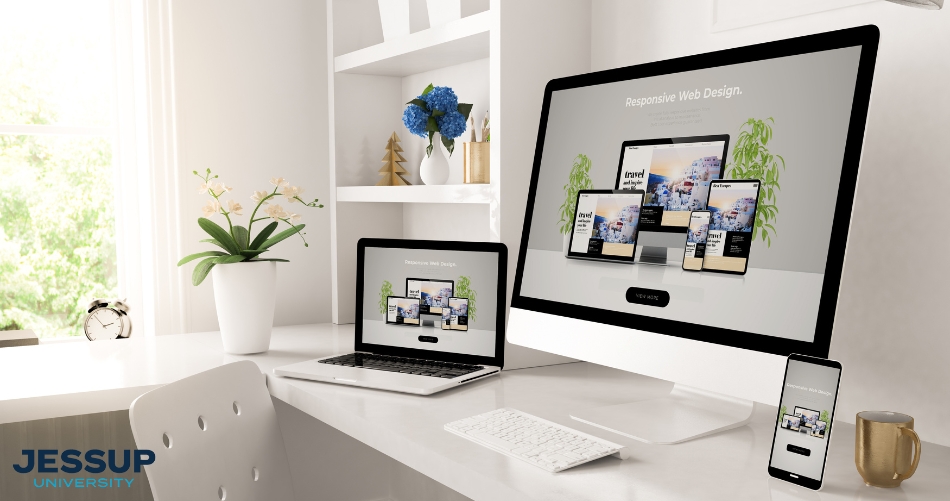Practical website design techniques to increase accessibility
Checking Out the Various Kinds Of Website Design and Their Distinct Advantages
The landscape of website design includes a selection of styles, each offering distinctive advantages that provide to different user demands. Minimal and level designs highlight quality, while responsive and material styles improve adaptability throughout tools. Illustrative and typography-driven strategies aim to increase interaction and psychological resonance. Recognizing these diverse types can substantially impact customer experience and brand name understanding. What exists underneath the surface area of these design selections?
Minimalist Website Design

Minimalist Web design usually includes a limited shade palette and simple typography, which not just boosts appearances yet additionally enhances brand identity. The lowered complexity can result in much faster filling times, additionally improving individual complete satisfaction. Additionally, by lessening aesthetic clutter, customers can involve with material much more successfully, resulting in improved understanding and retention. On the whole, minimal Web style cultivates a smooth individual experience, making it a preferred choice for brand names intending to convey clearness and professionalism and trust in their online existence.
Receptive Web Layout
Responsive Web design has actually become necessary in today's digital landscape, making sure mobile compatibility for customers throughout numerous gadgets. This strategy significantly enhances customer experience by giving smooth navigating and availability, no matter of screen size. As more people access the Web on smartphones and tablet computers, the value of receptive design proceeds to grow.

Mobile Compatibility Value
As mobile tool use remains to increase, making sure internet sites work with various screen dimensions has actually ended up being necessary for efficient interaction and engagement. Mobile compatibility, typically accomplished with responsive website design, enables web sites to adjust effortlessly to mobile phones, tablets, and other devices. This flexibility not only reaches a wider target market yet additionally boosts brand credibility. A website that operates well on smart phones shows professionalism and focus to individual demands. On top of that, search engines prioritize mobile-friendly websites in their rankings, making compatibility a crucial aspect for online presence. By purchasing mobile compatibility, companies can improve their electronic presence and deal with the expanding number of customers who access information on the move. Prioritizing mobile-responsive style is vital in today's digital landscape.
Improved Individual Experience

Flat Design
Flat style is a minimal approach to website design that emphasizes simpleness and clearness. By eliminating three-dimensional components such as darkness, textures, and gradients, level style produces an aesthetically attractive interface that focuses on web content and capability. This style promotes an instinctive navigation experience, as customers can quickly determine key attributes and activities without disturbance.
One of the primary benefits of flat style is its responsiveness across numerous devices and display sizes. Its clean lines and straightforward designs adjust seamlessly, guaranteeing a consistent experience for users on mobile, tablet, or desktop systems. Additionally, flat layout typically incorporates vibrant shades and typography, boosting visual influence and brand recognition.
The simpleness fundamental in flat design leads to quicker loading times, which adds favorably to individual satisfaction. In general, level design remains a popular choice for modern Web growth, straightening with modern visual preferences while providing outstanding functionality
Product Layout
Product Layout stands for a style language created by Google that concentrates on developing a natural and user-friendly individual experience throughout electronic systems. This technique stresses making use of grid-based layouts, responsive animations, and depth results such as lighting and shadows, which help to produce a sense of pecking order and spatial connections. By simulating the physical globe, Product Layout allows individuals to connect with electronic interfaces in an extra interesting and natural fashion.
One of the key advantages of Material Style is its flexibility across numerous devices and display sizes, making certain a regular experience for users. In addition, it advertises a clear visual language that boosts usability, making it less complicated for users to navigate intricate applications. The incorporation of vivid colors and strong typography additionally plays a vital duty in drawing interest to key aspects, therefore improving total user interaction - website design. Material Style has ended up being a prominent choice among developers seeking to produce practical and visually enticing websites.
Typography-Driven Style
Typography-Driven Layout concentrates on the tactical usage of type to improve the practical and visual facets of a site. This style method prioritizes typefaces, font dimensions, spacing, and power structure to develop visual rate of interest and guide individual experience. By carefully picking typography, developers can communicate brand identification and stimulate emotions, making the content more obtainable and appealing.
Efficient typography enhances readability and functionality, making sure that customers can conveniently navigate the site and absorb details. The appropriate combination of type can additionally establish a clear visual pecking order, enabling customers to swiftly recognize vital messages and view it now calls to action.
In addition, a typography-driven strategy can be adjusted to numerous tools, making certain consistency throughout platforms. This versatility is important in today's multi-device landscape, where user experience is extremely important. Eventually, Typography-Driven Design serves not only as an artistic choice however likewise as a functional aspect that substantially influences an internet site's effectiveness.
Illustratory Web Layout
Illustrative Web style utilizes aesthetic storytelling methods that can greatly improve individual involvement. By integrating unique illustrations, web sites can produce a remarkable brand name identification that reverberates with their target market. This approach not only astounds site visitors yet also communicates messages in a visually engaging fashion.
Aesthetic Narration Strategies
A wide range of Web designers employ visual storytelling techniques to create immersive and interesting individual experiences. This method combines typography, layout, and imagery to tell a tale that reverberates with users on an emotional degree. By incorporating compelling visuals, designers can efficiently convey messages and evoke feelings, guiding visitors via a brand's journey. Infographics, animations, and interactive components offer to boost stories, making intricate details extra memorable and accessible. In addition, visual narration can establish a natural brand identity, as constant imagery and motifs enhance core worths and messages. Eventually, this technique not only astounds individuals but also promotes a deeper connection with the web content, motivating expedition and retention. Through competent application, aesthetic storytelling transforms standard Web experiences right into purposeful and dynamic communications.
Enhancing User Involvement
Efficient Web design substantially boosts individual involvement by leveraging illustrative aspects that attract attention and foster interaction. Pictures can streamline intricate ideas, making them more friendly and remarkable for users. They break the uniformity of text-heavy pages, producing aesthetic breaks that invite expedition. Additionally, one-of-a-kind images can stimulate emotions, urging users to link with the web content on a deeper degree. Interactive aspects, such as computer animations or hover impacts, can additionally enhance engagement by inviting customers to get involved actively instead than passively taking in details. This approach not only keeps visitors on the site much longer yet also enhances the chance of return sees. Inevitably, effective illustrative Web style transforms the individual experience, making it a lot more delightful and impactful.
Branding With Picture
Visual aspects play a substantial duty in shaping a brand name's identification, and images are an effective device in this regard. Illustratory website design enables brand names to communicate their distinct character and values through customized artwork. This approach fosters a much deeper emotional connection with the audience, boosting memorability and interaction. By integrating pictures, brand names can differentiate themselves in a congested market, producing an unique aesthetic story that resonates with their target demographic. In addition, images can streamline complicated ideas and make material much more easily accessible, properly interacting messages in an interesting fashion. On the whole, branding through illustration not only enriches the individual experience yet also strengthens brand recognition, making it an important approach for companies intending to develop a solid on the internet presence.
Often Asked Concerns
How Do I Select the Right Web Layout Type for My Company?
To select the right website design kind for a company, one ought to analyze goals, target audience, and market criteria. Reviewing user experience and performance will certainly assist the choice procedure for optimal involvement and efficiency.
What Equipment Are Ideal for Developing Various Website Design Styles?
Popular tools for developing varied Web design styles include Adobe XD, Figma, Sketch, and WordPress. Each offers distinct functions customized to various layout needs, enabling designers to develop aesthetically enticing and useful websites efficiently.
Just How Much Does Specialist Website Design Typically Cost?
Specialist Web design generally sets you back between $2,000 and $10,000, relying on intricacy, attributes, and developer knowledge. Customized options and continuous upkeep may boost expenditures, while a knockout post layouts can supply even more economical choices for less complex tasks.
Can I Combine Several Website Design Enters Properly?
Yes, integrating several Web style types can be reliable. By incorporating aspects from more helpful hints different styles, developers can produce unique, appealing user experiences that satisfy diverse audiences while boosting performance and aesthetic appeal.
How Do Layout Fads Effect Customer Experience and Engagement?
Layout trends substantially influence customer experience and engagement by improving aesthetic allure, enhancing navigation, and cultivating emotional links - website design. Remaining updated with fads enables developers to produce user-friendly user interfaces that reverberate with users and urge long term communications
Flat and minimalist designs emphasize clearness, while receptive and worldly designs enhance adaptability throughout tools. It may appear counterintuitive, minimal Web design emphasizes simplicity to boost customer experience. Responsive Web style plays a vital role in enhancing individual experience by making certain that a site adapts seamlessly to numerous display sizes and gadgets. Level layout is a minimalist approach to Web style that highlights simpleness and quality. Material Design represents a design language created by Google that concentrates on creating a instinctive and natural customer experience throughout electronic systems.